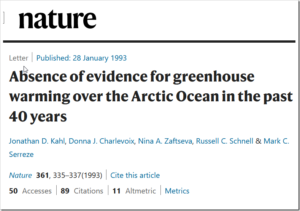by P. Homewood, March 23, 2020 in NotaLotofPeopleKnowThat
We are familiar with the incessant claims that the Arctic is one of the fastest warming regions on Earth, and that this is due to the polar amplification effect of greenhouse gases.
But scientists back in the 1990s found that this theory did not stack up then:
Abstract
ATMOSPHERIC general circulation models predict enhanced greenhouse warming at high latitudes1owing to positive feedbacks between air temperature, ice extent and surface albedo2–4. Previous analyses of Arctic temperature trends have been restricted to land-based measurements on the periphery of the Arctic Ocean5,6. Here we present temperatures measured in the lower troposphere over the Arctic Ocean during the period 1950–90. We have analysed more than 27,000 temperature profiles, measured by radiosonde at Russian drifting ice stations and by dropsonde from US ‘Ptarmigan’ weather reconnaissance aircraft, for trends as a function of season and altitude. Most of the trends are not statistically significant. In particular, we do not observe the large surface warming trends predicted by models; indeed, we detect significant surface cooling trends over the western Arctic Ocean during winter and autumn. This discrepancy suggests that present climate models do not adequately incorporate the physical processes that affect the polar regions.
https://www.nature.com/articles/361335a0
The cooling between 1950 and 1990 is very evident at a whole range of land sites on the fringes of the Arctic, ranging from Greenland right through to eastern Siberia.
…

